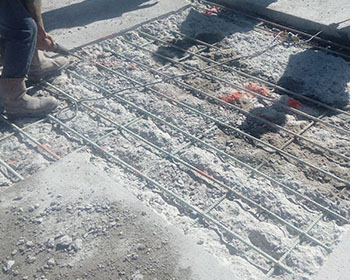

Research Reports |
| Title: | Improved Sustainability and Efficiency of Partial-Depth Concrete Bridge Deck Repair |
| Authors: | Andrew D. Sorensen and Israi I.H. Abu Shanab |
| University: | Utah State University |
| Publication Date: | Aug 2024 |
| Report #: | MPC-24-540 |
| Project #: | MPC-661 |
| TRID #: | 01933536 |
| Keywords: | alternatives analysis, bridge decks, concrete bridges, cracking, environmental impacts, repairing |
| Type: | Research Report – MPC Publications |
 Recently, significant advances have been made in the development of rapid setting cementitious materials for partial-depth bridge deck repair. The rapid set times of these materials allow for traffic to be re-opened onto the bridge deck in several hours versus days once the material has been placed. While this is a substantial improvement in reducing traffic closure time, much time is still spent on the removal of damaged and deteriorated bridge deck and in preparing the concrete cutouts for placement of the rapid set material. Partial deck removal is a much more delicate process than full deck or pavement roadway removal as the soundness of the concrete surrounding and below the cutout must be maintained. Therefore, the patch preparation process is extremely labor intensive. With the recent development of autonomous machinery, this labor-intensive process may be able to become more efficient. However, prior to developing autonomous machines to prepare the patches, foundational research on methods that reduce the preparation time and that can be easily automated needs to be carried out. Additionally, some removal and preparation methods have more of an environmental impact than others.
Recently, significant advances have been made in the development of rapid setting cementitious materials for partial-depth bridge deck repair. The rapid set times of these materials allow for traffic to be re-opened onto the bridge deck in several hours versus days once the material has been placed. While this is a substantial improvement in reducing traffic closure time, much time is still spent on the removal of damaged and deteriorated bridge deck and in preparing the concrete cutouts for placement of the rapid set material. Partial deck removal is a much more delicate process than full deck or pavement roadway removal as the soundness of the concrete surrounding and below the cutout must be maintained. Therefore, the patch preparation process is extremely labor intensive. With the recent development of autonomous machinery, this labor-intensive process may be able to become more efficient. However, prior to developing autonomous machines to prepare the patches, foundational research on methods that reduce the preparation time and that can be easily automated needs to be carried out. Additionally, some removal and preparation methods have more of an environmental impact than others.
The overall objective of this study is to examine different removal methods to decrease traffic closure time due to the preparation process for partial-depth replacement, improve the efficiency of the concrete removal methods, and evaluate the life cycle sustainability of those techniques. The initial portion of the study evaluates the current partial deck removal techniques currently used in practice, including sawing, jackhammering, milling, and hydro-demolition. Each of these methods has advantages and disadvantages when it comes to partial deck removal.
A comparative study of the different concrete removal methods is carried out to identify the least invasive environmental removal technique for partial-depth bridge deck repair. An experimental study is designed to remove the concrete patches using different discretized sawing-jackhammering methods to evaluate those techniques based on removal time, life cycle sustainability, and effect on the concrete surrounding the patch. Furthermore, the different equipment used during the concrete removal process is evaluated to assess the minor and major cracks, which could develop because of concrete failure. For example, using a hydro-demolition technique for partial-depth repair causes a punch-through problem. A small-trial water jet experiment that impacts concrete is conducted to investigate the influenced parameters of punch-through occurrence.
Sorensen, Andrew D., and Israi I.H. Abu Shanab. Improved Sustainability and Efficiency of Partial-Depth Concrete Bridge Deck Repair, MPC-24-540. North Dakota State University - Upper Great Plains Transportation Institute, Fargo: Mountain-Plains Consortium, 2024.